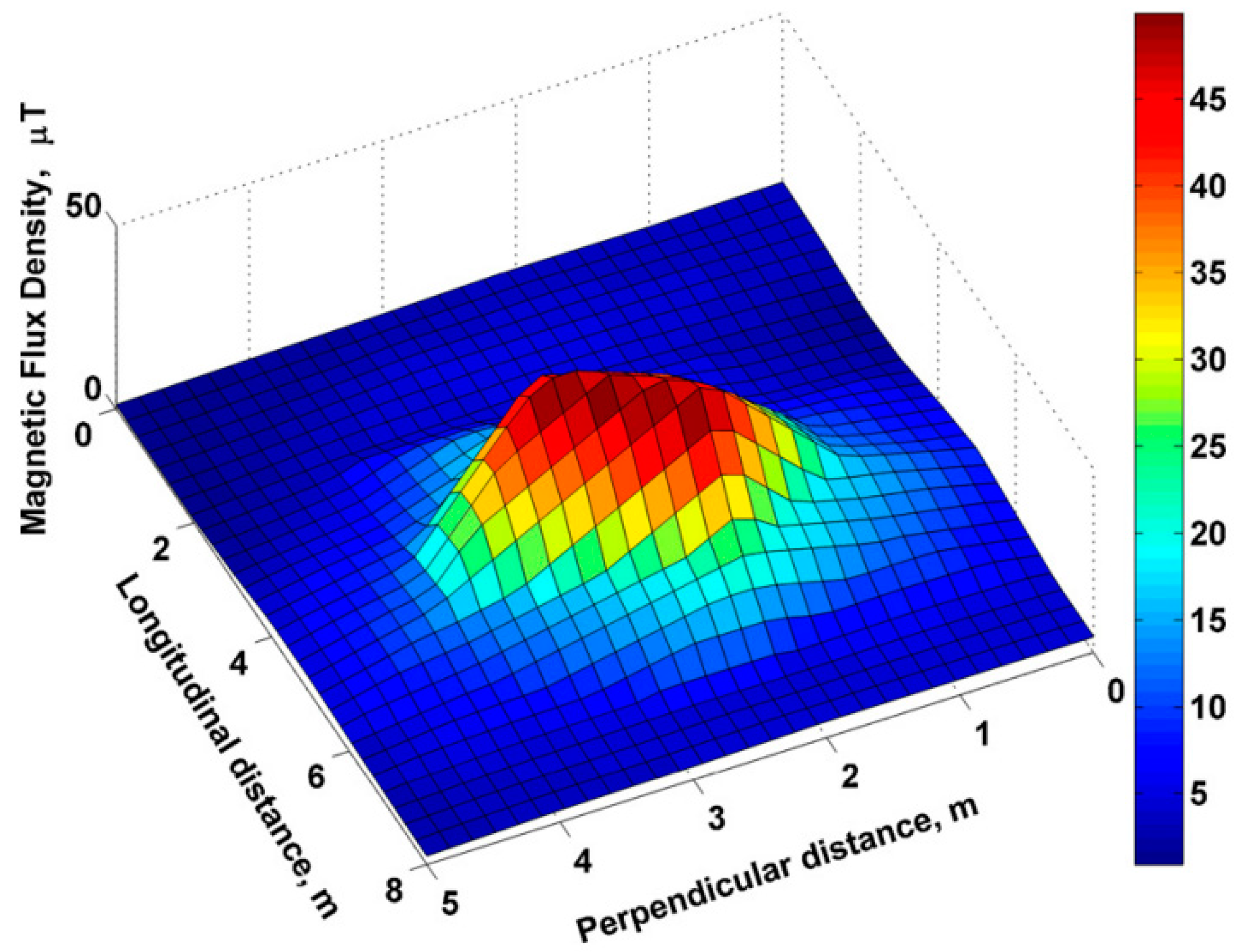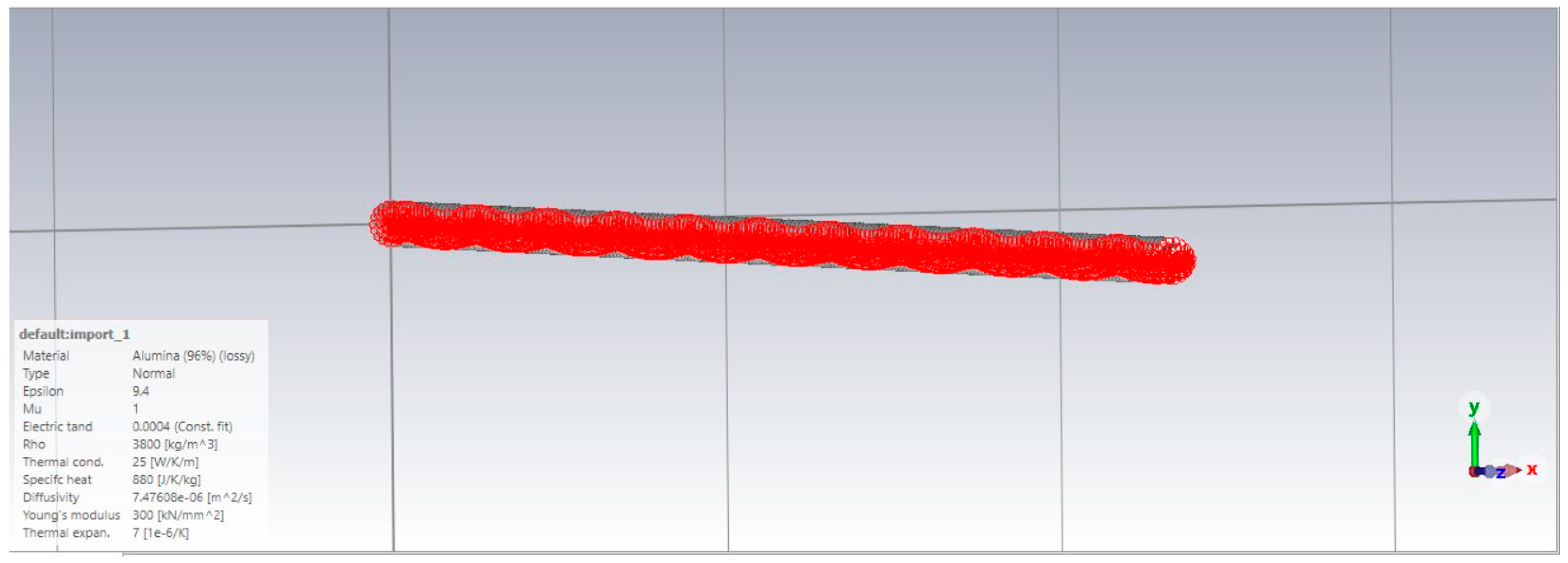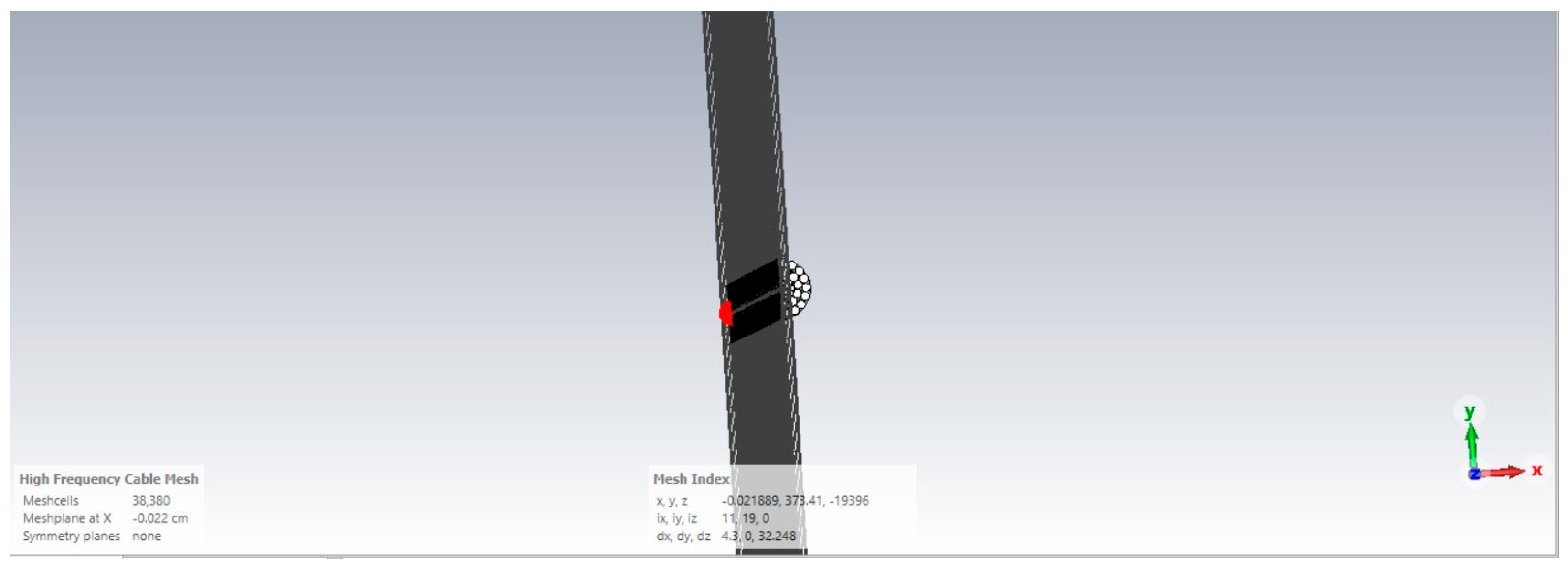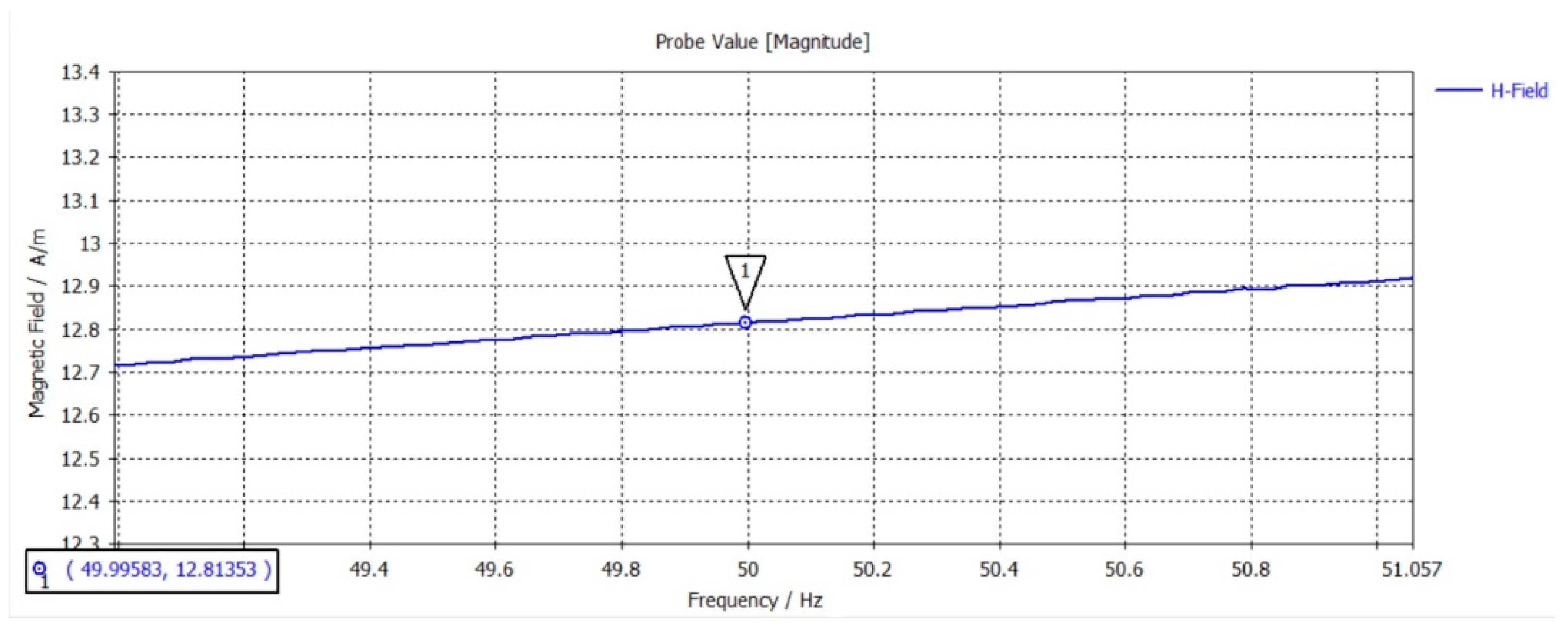Sustainable Maintenance of Conductors in Transmission/Distribution Networks Using Complex Magnetic Field Analysis
Abstract
:1. Introduction
- Up to 1 Hz, exposure limit values are provided for current density for time-varying fields to prevent effects on the cardiovascular system and the central nervous system;
- Between 1 Hz and 10 MHz, exposure limit values are provided for the current density, with the aim of preventing effects on central nervous system functions;
- Between 100 kHz and 10 GHz, Specific Absorption Rate (SAR) exposure limit values are provided to prevent whole-body thermal stress and localized tissue overheating.
2. Experimental Determination
3. Field Modeling
4. Results and Conclusions
5. Discussion
Author Contributions
Funding
Institutional Review Board Statement
Informed Consent Statement
Data Availability Statement
Acknowledgments
Conflicts of Interest
References
- Directive 2013/35/EU of the European Parliament and of the Council of 26 June 2013 on the Minimum Health and Safety Requirements Regarding the Exposure of Workers to the Risks Arising from Physical Agents (Electromagnetic Fields) (20th Individual Directive within the Meaning of Article 16(1) of Directive 89/391/EEC) and Repealing Directive 2004/40/EC. Available online: https://eurlex.europa.eu/LexUriServ.do?uri=OJ:L:2004:184:0001:0009:EN:PDF (accessed on 11 May 2024).
- Decision No. 520/2016 Regarding the Minimum Safety and Health Requirements Regarding the Exposure of Workers to Risks Generated by Electromagnetic Fields—In Romanian, Published in the Official Gazette No. 576 of 28 July 2016. Available online: https://mmuncii.ro/j33/images/Documente/Legislatie/HG520-2016.pdf (accessed on 9 May 2024).
- Laakso, I.; Tsuchida, S.; Hirata, A.; Kamimura, Y. Evaluation of SAR in a human body model due to wireless power transmission in the 10 MHz band. Phys. Med. Biol. 2012, 57, 4991. [Google Scholar] [CrossRef] [PubMed]
- IEEE Standard C95.1-2019; IEEE Standard for Safety Levels with Respect to Human Exposure to Electric, Magnetic, and Electromagnetic Fields, 0 Hz to 300 GHz (Revision to IEEE 2006 IEEE C95.1). IEEE: New York, NY, USA, 2019.
- Araújo Alves, J.; Neto Paiva, F.; Torres Silva, L.; Remoaldo, P. Low-Frequency Noise and Its Main Effects on Human Health—A Review of the Literature between 2016 and 2019. Appl. Sci. 2020, 10, 5205. [Google Scholar] [CrossRef]
- Hirata, A.; Laakso, I.; Oizumi, T.; Hanatani, R.; Chan, K.H.; Wiart, J. The relationship between specific absorption rate and temperature elevation in anatomically based human body models for plane wave exposure from 30 MHz to 6 GHz. Phys. Med. Biol. 2013, 58, 903. [Google Scholar] [CrossRef] [PubMed]
- Morimoto, R.; Laakso, I.; De Santis, V.; Hirata, A. Relationship between peak spatial-averaged specific absorption rate and peak temperature elevation in human head in frequency range of 1–30 GHz. Phys. Med. Biol. 2016, 61, 5406. [Google Scholar] [CrossRef] [PubMed]
- ORDER no. 1193 of 29 September 2006 for the Approval of the Norms on Limiting the Exposure of the General Population to Electromagnetic Fields from 0 Hz to 300 GHz. Available online: https://www.ancom.ro/uploads/links_files/Odinul_1193_2006_norme.pdf (accessed on 28 April 2024). (In Romanian).
- Sharma, G.P.; Himburg, H.A. Organ-Specific Endothelial Dysfunction Following Total Body Irradiation Exposure. Toxics 2022, 10, 747. [Google Scholar] [CrossRef] [PubMed]
- Voicu, V.; Dina, L.-A.; Mircea, P.-M.; Dumbrava, I. Magnetic and Electric Field Measurement Experiments. In Proceedings of the 2023 Power Quality and Electromagnetic Compatibility at Low Frequency (PQEMC-LF), Craiova, Romania, 28–30 June 2023; pp. 61–64. [Google Scholar] [CrossRef]
- Russ, E.; Davis, C.M.; Slaven, J.E.; Bradfield, D.T.; Selwyn, R.G.; Day, R.M. Comparison of the Medical Uses and Cellular Effects of High and Low Linear Energy Transfer Radiation. Toxics 2022, 10, 628. [Google Scholar] [CrossRef] [PubMed]
- Holbert, K.E.; Karady, G.G.; Adhikari, S.G.; Dyer, M.L. Magnetic fields produced by underground residential distribution system. IEEE Trans. Power Deliv. 2009, 24, 1616–1622. [Google Scholar] [CrossRef]
- Voicu, V.; Dina, L.-A.; Dumbrava, I.; Mircea, P.-M.; Fieraru, I. Experiments on the Measurement of the Electromagnetic Field. In Proceedings of the 2023 International Conference on Electromechanical and Energy Systems (SIELMEN), Craiova, Romania, 11–13 October 2023; pp. 1–6. [Google Scholar] [CrossRef]
- Voicu, V.; Pătru, I.; Dina, L.-A.; Nicolae, P.-M.; Smărăndescu, I.D. Shielding effectiveness evaluation using a non-standardized method. In Proceedings of the 2017 International Conference on Electromechanical and Power Systems (SIELMEN), Iasi, Romania, 11–13 October 2017; pp. 208–211. [Google Scholar] [CrossRef]
- Voicu, V.; Pătru, I.; Nicoleanu, A.; Dina, A.; Smărăndescu, D.; Nicolae, M.; Aipu, R.A. Modeling the Electromagnetic Field Distribution Inside an Anechoic Chamber Lined with Different Types of Radio-Frequency Absorbers. In Proceedings of the 2018 IEEE Symposium on Electromagnetic Compatibility, Signal Integrity and Power Integrity (EMC, SI & PI), Long Beach, CA, USA, 30 July–3 August 2018; pp. 175–180. [Google Scholar] [CrossRef]
- Voicu, V.; Pătru, I.; Nicolae, P.-M.; Dina, L.-A. Analyzing the attenuation of electromagnetic shielding materials for frequencies under 1 GHz. In Proceedings of the 2017 10th International Symposium on Advanced Topics in Electrical Engineering (ATEE), Bucharest, Romania, 23–25 March 2017; pp. 336–339. [Google Scholar] [CrossRef]
- Voicu, V.; Dina, L.-A.; Nicolae, P.-M.; Aipu, R.A.; Pătru, I.; Nicoleanu, P.-A. Modeling the Electromagnetic Field Distribution in a Shielded Enclosure Lined with Radio-Frequency Absorbers. In Proceedings of the 2018 International Conference on Applied and Theoretical Electricity (ICATE), Craiova, Romania, 4–6 October 2018; pp. 1–5. [Google Scholar] [CrossRef]
- Dina, L.-A. Electromagnetic Field Modeling in EMC Test chambers; Sitech: Craiova, Romania, 2024; ISBN 978-606-11-8572-6. [Google Scholar]
- Osmani, K.; Schulz, D. Modeling Magnetic Fields around Stranded Electrical Transmission Lines via Finite Element Analysis (FEA). Energies 2024, 17, 801. [Google Scholar] [CrossRef]
- Deltuva, R.; Lukočius, R. Distribution of Magnetic Field in 400 kV Double-Circuit Transmission Lines. Appl. Sci. 2020, 10, 3266. [Google Scholar] [CrossRef]
- Nicolaou, C.; Papadakis, A.; Razis, P.; Kyriacou, G.; Sahalos, J. Experimental measurement, analysis and prediction of electric and magnetic fields in open type air substations. Electr. Power Syst. Res. 2012, 90, 42–54. [Google Scholar] [CrossRef]
- Gierczak, M.; Markowski, P.M.; Dziedzic, A. The Modeling of Magnetic Fields in Electromagnetic Microgenerators Using the Finite Element Method. Energies 2022, 15, 1014. [Google Scholar] [CrossRef]
- Mamishev, A.V.; Nevels, R.D.; Russell, B.D. Effects of conductor sag on spatial distribution of power line magnetic field. IEEE Trans. Power Deliv. 1996, 11, 1571–1576. [Google Scholar] [CrossRef]
- Budnik, K.; Machczyński, W. Contribution to studies on calculation of the magnetic field under power lines. Eur. Trans. Electr. Power 2006, 16, 345–364. [Google Scholar] [CrossRef]
- Modric, S.V.T.; Lovric, D. 3D computation of the power lines magnetic field. Prog. Electromagn. Res. M 2015, 41, 1–9. [Google Scholar] [CrossRef]
- Yang, Y.; Yin, Q.; Li, C.; Li, H.; Zhang, H. Simulation and Experimental Verification of Magnetic Field Diffusion at the Launch Load during Electromagnetic Launch. Sensors 2023, 23, 8007. [Google Scholar] [CrossRef] [PubMed]
- Su, Z.; Wei, R.; Du, Y.; Fan, W.; Chen, J. Numerical Simulation of Magnetic Field and Flow Field of Slab under Composite Magnetic Field. Metals 2023, 13, 1237. [Google Scholar] [CrossRef]
- Chan, J.; Havard, D.; Rawlins, C.; Diana, G.; Cloutier, L.; Lilien, J.L.; Hardy, C.; Wang, J.; Goel, A. EPRI Transmission Line Reference Book: Wind Induced Conductor Motion; Electric Power Research Institute: Palo Alto, CA, USA, 2006. [Google Scholar]
- Rizzo, P.; Di-Scalea, F.L. Monitoring steel strands via ultrasonic measurements. In Smart Structures and Materials 2002: Smart Systems for Bridges, Structures, and Highways; SPIE: Washington, DC, USA, 2002; Volume 4696, pp. 62–73. [Google Scholar]
- Wilson, M.; Hurlebaus, S. Power line monitoring. In Proceedings of the 2007 American Control Conference, New York, NY, USA, 9–13 July 2007; pp. 231–235. [Google Scholar]
- Černín, K. Reconstruction of Conductor Movement and Monitoring of High Voltage. Ph.D. Thesis, Brno University of Technology, Brno, Czechia, 2009. [Google Scholar]
- Baltazar, A.; Hernandez-Salazar, C.D.; Manzanares-Martinez, B. Study of wave propagation in a multiwire cable to determine structural damage. NDTE Int. 2010, 43, 726–732. [Google Scholar] [CrossRef]
- ASTM E-1876-01; Standard Test Method for Dynamic Young’s Modulus, Shear Modulus, and Poisson’s Ratio by Impulse Excitation Technique of Vibration. ASTM International: West Conshohocken, PA, USA, 2017.
- Matthes, R.; McKinlay, A.F.; Bernhardt, J.H.; Vecchia, P.; Veyret, B. Exposure to Static and Low Frequency Electromagnetic Fields Biological Effects and Health Consequences (0-100 kHz)—Review of the Scientific Evidence Munich 2003; ICNIRP 13/2003; ICNIRP: Munich, Germany, 2003; ISBN 978-3-934994-03-4. [Google Scholar]










| Frequency Range | Magnetic Induction AL(B) Low-Frequency [µT] (RMS) | Magnetic Induction AL(B) High-Frequency [µT] (RMS) | Magnetic Induction AL for Exposure of Limbs to Localized Magnetic Field [µT] (RMS) |
|---|---|---|---|
| 1 ≤ f ≤ 8 Hz | 2.0 × 105/f2 | 3.0 × 105/f | 9.0 × 105/f |
| 8 ≤ f ≤ 25 Hz | 2.5 × 104/f | 3.0 × 105/f | 9.0 × 105/f |
| 25 ≤ f ≤ 300 Hz | 1.0 × 103 | 3.0 × 105/f | 9.0 × 105/f |
| 300 Hz ≤ f ≤ 3 kHz | 3.0 × 105/f | 3.0 × 105/f | 9.0 × 105/f |
| 3 kHz ≤ f ≤ 100 MHz | 1.0 × 102 | 1.0 × 102 | 3.0 × 102 |
| 100 kHz ≤ f ≤ 1 MHz | 2.0 × 106/f | - | - |
| 1 ≤ f ≤ 10 MHz | 2.0 × 106/f | - | - |
| 10 ≤ f ≤ 400 MHz | 0.2 | - | - |
| 400 MHz ≤ f ≤ 2 GHz | 1.0 × 10−5 f1/2 | - | - |
| 2 ≤ f ≤ 6 GHz | 4.5 × 10−1 | - | - |
| 6 ≤ f ≤ 300 | 4.5 × 10−1 | - | - |
| Frequency Range | Magnetic Field Intensity (A/m) | Magnetic Induction (µT) | The Power Density of the Equivalent Plane Wave Seq (W/m2) |
|---|---|---|---|
| 0–1 Hz | 3.2 × 104 | 4 × 104 | - |
| 1–8 Hz | 3.2 × 104 /f2 | 4 × 104/f2 | - |
| 8–25 Hz | 4000 /f | 5000/f | - |
| 0.025–0.8 kHz | 4/f | 5/f | - |
| 0.8–3 kHz | 5 | 6.25 | - |
| 3–150 kHz | 5 | 6.25 | - |
| 0.15–1 MHz | 0.73/f | 0.92/f | |
| 1–10 MHz | 0.73/f | 0.92/f | |
| 10–400 MHz | 0.73 | 0.92 | 2 |
| 400–2000 MHz | 0.037∙f1/2 | 0.046∙f1/2 | f/200 |
| 2–300 GHz | 0.16 | 0.2 | 10 |
| Frequency Range | Magnetic Induction (µT) | Medium SAR in All Body (W/m2) | The Power Density of the Equivalent Plane Wave Seq (W/m2) |
|---|---|---|---|
| 0 Hz | 40 | - | - |
| 0–1 Hz | - | - | - |
| 1–4 Hz | - | - | - |
| 4–1000 Hz | - | - | - |
| 1000 Hz–100 kHz | - | - | - |
| 100 kHz–10 MHz | - | - | 0.08 |
| 10 MHz–10 GHz | - | - | 0.08 |
| 10 GHz–300 GHz | - | 10 | - |
| Measurement | The Measured Value (μT) | Frequency (Hz) | Limit 2013/35/EU (μT) | Measurement | The Measured Value (μT) | Frequency (Hz) | Limit 2013/35/EU (μT) |
|---|---|---|---|---|---|---|---|
| 1 | 9.97 | 50 | 1000 | 19 | 9.96 | 50 | 1000 |
| 2 | 9.95 | 50 | 1000 | 20 | 9.94 | 50 | 1000 |
| 3 | 9.97 | 51 | 1000 | 21 | 9.92 | 50 | 1000 |
| 4 | 9.98 | 50 | 1000 | 22 | 9.99 | 51 | 1000 |
| 5 | 9.97 | 51 | 1000 | 23 | 9.94 | 50 | 1000 |
| 6 | 9.98 | 50 | 1000 | 24 | 9.91 | 51 | 1000 |
| 7 | 9.97 | 50 | 1000 | 25 | 9.90 | 50 | 1000 |
| 8 | 9.98 | 51 | 1000 | 26 | 9.88 | 51 | 1000 |
| 9 | 9.98 | 51 | 1000 | 27 | 9.90 | 50 | 1000 |
| 10 | 9.97 | 50 | 1000 | 28 | 9.90 | 51 | 1000 |
| 11 | 9.97 | 51 | 1000 | 29 | 9.90 | 50 | 1000 |
| 12 | 9.97 | 50 | 1000 | 30 | 9.88 | 50 | 1000 |
| 13 | 9.96 | 50 | 1000 | 31 | 9.90 | 50 | 1000 |
| 14 | 9.96 | 51 | 1000 | 32 | 9.91 | 51 | 1000 |
| 15 | 9.95 | 50 | 1000 | 33 | 9.89 | 50 | 1000 |
| 16 | 9.95 | 51 | 1000 | 34 | 9.90 | 51 | 1000 |
| 17 | 9.94 | 50 | 1000 | 35 | 9.89 | 51 | 1000 |
| 18 | 9.95 | 51 | 1000 | 36 | 9.88 | 51 | 1000 |
| Measurement | The Measured Value (μT) | Frequency (Hz) | Limit 2013/35/EU (μT) | Measurement | The Measured Value (μT) | Frequency (Hz) | Limit 2013/35/EU (μT) |
|---|---|---|---|---|---|---|---|
| 1 | 18.49 | 51 | 1000 | 19 | 18.71 | 50 | 1000 |
| 2 | 18.57 | 51 | 1000 | 20 | 18.72 | 51 | 1000 |
| 3 | 18.51 | 50 | 1000 | 21 | 18.65 | 50 | 1000 |
| 4 | 18.70 | 50 | 1000 | 22 | 18.77 | 50 | 1000 |
| 5 | 18.64 | 50 | 1000 | 23 | 18.71 | 51 | 1000 |
| 6 | 18.68 | 50 | 1000 | 24 | 18.69 | 51 | 1000 |
| 7 | 18.67 | 51 | 1000 | 25 | 18.77 | 50 | 1000 |
| 8 | 18.63 | 50 | 1000 | 26 | 18.72 | 50 | 1000 |
| 9 | 18.68 | 51 | 1000 | 27 | 18.74 | 50 | 1000 |
| 10 | 18.67 | 50 | 1000 | 28 | 18.79 | 50 | 1000 |
| 11 | 18.64 | 51 | 1000 | 29 | 18.74 | 51 | 1000 |
| 12 | 18.66 | 50 | 1000 | 30 | 18.73 | 51 | 1000 |
| 13 | 18.76 | 50 | 1000 | 31 | 18.75 | 50 | 1000 |
| 14 | 18.73 | 50 | 1000 | 32 | 18.77 | 51 | 1000 |
| 15 | 18.75 | 51 | 1000 | 33 | 18.76 | 50 | 1000 |
| 16 | 18.69 | 51 | 1000 | 34 | 18.75 | 51 | 1000 |
| 17 | 18.67 | 51 | 1000 | 35 | 18.73 | 50 | 1000 |
| 18 | 18.70 | 51 | 1000 | 36 | 18.75 | 51 | 1000 |
| The Analytical Value (A/m) | The Analytical Value (μT) | Frequency (Hz) | Limit 2013/35/EU (μT) |
|---|---|---|---|
| 12.719 | 15.983 | 49 | 1000 |
| 12. 738 | 16.007 | 49.2 | 1000 |
| 12. 763 | 16.038 | 49.4 | 1000 |
| 12.779 | 16.058 | 49.6 | 1000 |
| 12.804 | 16.089 | 49.8 | 1000 |
| 12.820 | 16.110 | 50 | 1000 |
| 12.830 | 16.122 | 50.2 | 1000 |
| 12.864 | 16.165 | 50.4 | 1000 |
| 12.879 | 16.184 | 50.6 | 1000 |
| 12.892 | 16.200 | 50.8 | 1000 |
| 12.911 | 16.224 | 51 | 1000 |
| The Analytical Value (A/m) | The Analytical Value (μT) | Frequency (Hz) | Limit 2013/35/EU (μT) |
|---|---|---|---|
| 6.369 | 8.003 | 49 | 1000 |
| 6. 376 | 8.012 | 49.2 | 1000 |
| 6. 382 | 8.019 | 49.4 | 1000 |
| 6.395 | 8.036 | 49.6 | 1000 |
| 6.404 | 8.047 | 49.8 | 1000 |
| 6.409 | 8.053 | 50 | 1000 |
| 6.411 | 8.056 | 50.2 | 1000 |
| 6.423 | 8.071 | 50.4 | 1000 |
| 6.436 | 8.087 | 50.6 | 1000 |
| 6.441 | 8.093 | 50.8 | 1000 |
| 6.451 | 8.099 | 51 | 1000 |
Disclaimer/Publisher’s Note: The statements, opinions and data contained in all publications are solely those of the individual author(s) and contributor(s) and not of MDPI and/or the editor(s). MDPI and/or the editor(s) disclaim responsibility for any injury to people or property resulting from any ideas, methods, instructions or products referred to in the content. |
© 2024 by the authors. Licensee MDPI, Basel, Switzerland. This article is an open access article distributed under the terms and conditions of the Creative Commons Attribution (CC BY) license (https://creativecommons.org/licenses/by/4.0/).
Share and Cite
Dina, L.-A.; Voicu, V.; Dumbrava, I.; Mircea, P.-M.; Nicolae, I.D. Sustainable Maintenance of Conductors in Transmission/Distribution Networks Using Complex Magnetic Field Analysis. Sustainability 2024, 16, 6659. https://doi.org/10.3390/su16156659
Dina L-A, Voicu V, Dumbrava I, Mircea P-M, Nicolae ID. Sustainable Maintenance of Conductors in Transmission/Distribution Networks Using Complex Magnetic Field Analysis. Sustainability. 2024; 16(15):6659. https://doi.org/10.3390/su16156659
Chicago/Turabian StyleDina, Livia-Andreea, Viorica Voicu, Ionel Dumbrava, Paul-Mihai Mircea, and Ileana Diana Nicolae. 2024. "Sustainable Maintenance of Conductors in Transmission/Distribution Networks Using Complex Magnetic Field Analysis" Sustainability 16, no. 15: 6659. https://doi.org/10.3390/su16156659
APA StyleDina, L.-A., Voicu, V., Dumbrava, I., Mircea, P.-M., & Nicolae, I. D. (2024). Sustainable Maintenance of Conductors in Transmission/Distribution Networks Using Complex Magnetic Field Analysis. Sustainability, 16(15), 6659. https://doi.org/10.3390/su16156659






